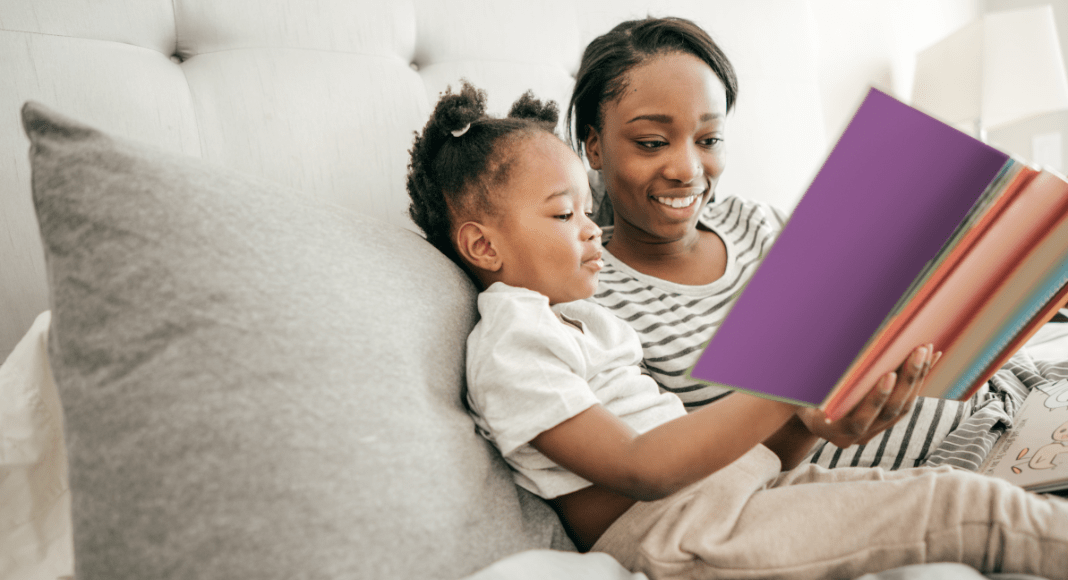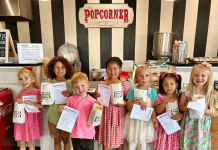 Do you know how to read aloud with your child? What a silly question. Of course you know how to read with your youngster. Right?
Do you know how to read aloud with your child? What a silly question. Of course you know how to read with your youngster. Right?
But, is your child getting the most out of your story time together? Is your read-aloud packing a punch?
Becoming a Nation of Readers: The Report of the Commission on Reading that came out in 1985 says, “the single most important activity for building knowledge for a child’s eventual success in reading is reading aloud to children.”¹
If story time is that important, then we should make it count. Do you agree?
What is Dialogic Reading?
Believe it or not, how you read to your child is just as important as how much you read. In the 1980s, a child development expert named Dr. Grover Whitehurst developed a program that gives children a leg up in learning to read. The program is called Dialogic Reading and it reverses the role of adult and child when reading. Giving your child an opportunity to tell the story in the book to you, rather than the other way around, keeps him more interested and engaged, thereby making the reading more interactive. Simply put, dialogic reading is having a conversation, or dialogue, with your child about the book you are sharing.
Using the PEER Sequence
In dialogic reading, a book is read multiple times, with subsequent readings focusing on different areas of comprehension. On each page of the book, you and your child quickly go through a series of questions called the PEER sequence.²
- Prompt your child to say something about the book.
- Evaluate your child’s response.
- Expand his response by rephrasing and adding information to it
- Repeat the prompt to make sure he has learned from the expansion.
Ask Questions to Aid Comprehension
During the PEER sequence, ask five types of questions. Using the word CROWD will help you to remember the questions.
- Completion prompts: Leave a blank at the end of a sentence and see if your child can fill it in. Use with books that rhyme or have repetitive phrases.
- Mary had a little lamb, its fleece was white as snow. And everywhere that Mary went the lamb was sure to __________ (go.)
- Recall prompts: Questions about what happened in the book after you have read it at least once. “What happened in the story to the _____?”
- What happened to the lamb when it followed Mary to school?
- Open-ended prompts: Questions that focus on the pictures in books. “What’s happening in this picture?”
- Look at the picture of Mary and her lamb at school. What are the children doing in this picture? Why do you think they are doing that?
- Wh- prompts: Questions beginning with who, what, when, where, why, and how-teaching new vocabulary, focusing on the pictures in books.
- Who is at school? What is fleece? When is the story happening? Where does most of the story take place? Why are the students laughing?
- Distancing prompts: Questions relating the pictures or words in the book to real-life experiences outside the book.
- Have you ever seen a lamb? Where did you see it? If you had a lamb, would you take it to school with you?
Once you have chosen a book to read dialogically, read it through the first time without interruption. Use the PEER sequence to ask CROWD questions at each additional reading. The dialogic reading strategy works equally well with fiction and nonfiction books.
Change Your Focus Each Time You Read
On the second reading, focus on the book’s vocabulary. Choose up to ten words from the story that may be unfamiliar to your child. Discuss the meaning of each word when you come across it in the text. Having a visual representation of the word also helps with recall and comprehension. Use open-ended, WH, and distancing prompts during this reading.
When you read the book for the third time, concentrate on expansion. Guide your child to tell you what is happening on a page and then expand his answer with more information. Ask open-ended, WH, and distancing questions.
During the fourth and subsequent readings, encourage your child to tell the story using vocabulary he has learned. Ask all types of questions during these readings to make sure comprehension is intact. Give an opportunity for your son or daughter to ask you questions about the story as well.
Benefits of Dialogic Reading
Dialogic reading is an easy way to get the most out of story time. Research has shown that dialogic reading³:
- improves expressive language abilities
- increases vocabulary
- helps a child identify sounds and letters
- improves emergent writing skills, such as printing from left to right
- improves ability to distinguish between uppercase and lowercase letters
- helps children learn to write their own names
- enhances knowledge of print concepts
- gains were retained over time
Dialogic reading is easy, interactive, interesting, and fun! Give it a try the next time you and your child read and see the difference that a little conversation can make. Most of all, enjoy story time with your child.
¹ Anderson, R. C., Hiebert, E. H., Scott, J. A., Wilkinson, I. A. G., Becker, W., & Becker, W. C. (1988). BECOMING A NATION OF READERS: THE REPORT OF THE COMMISSION ON READING. Education and Treatment of Children, 11(4), 389–396.
² Dialogic Reading: An Effective Way to Read Aloud with Young Children
³ Grover J. (Russ) Whitehurst, Ph.D., Director, Institute of Education Sciences, U.S. Department of Education.
 I am Jill Hodge, an educator with 32 years of teaching experience. After 19 years as a reading specialist in the Andover Public Schools and 28 total years of teaching, I retired in 2019 and began my career as a Literacy Intervention Specialist at Rolph Literacy Academy, part of the Phillips Fundamental
I am Jill Hodge, an educator with 32 years of teaching experience. After 19 years as a reading specialist in the Andover Public Schools and 28 total years of teaching, I retired in 2019 and began my career as a Literacy Intervention Specialist at Rolph Literacy Academy, part of the Phillips Fundamental
Learning Center. Beginning this year, I will be a part of the teacher training team at PFLC.
My husband David, our two children and their spouses Lauren and Ben Davis and Bill and Alexa Hodge, and my beautiful grandsons Henry, James, and Jackson are all avid readers!















